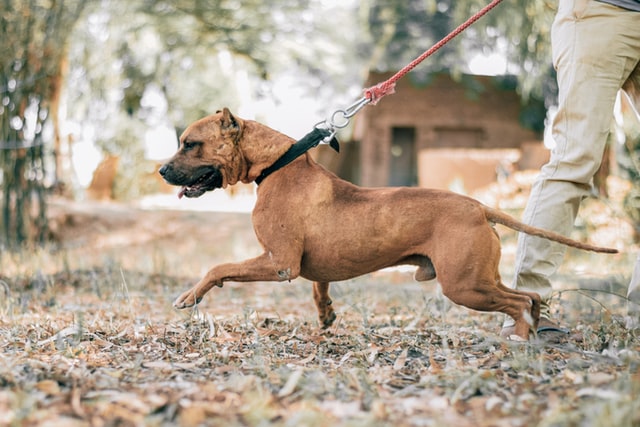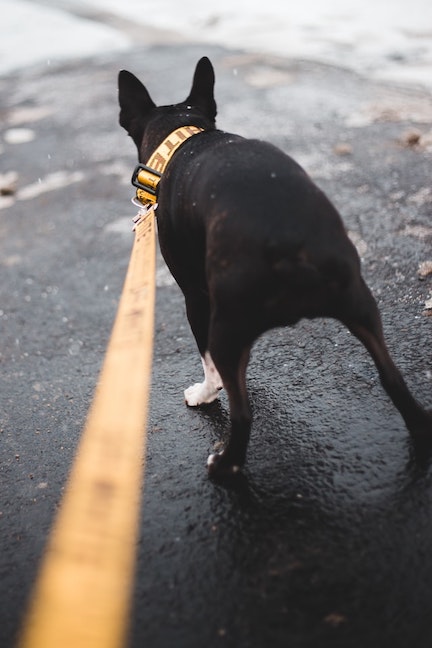Pet Insurance Review > Pet Wellness Guides > 4 Dog Training Tips For Leash Aggression - Pet Insurance Review
4 Dog Training Tips For Leash Aggression
Posted: 06/27/2022 | BY: Lacy Bursick | Categories: Behavior , Dog
Socializing your dog is integral to their development, but what if your dog is so reactive and aggressive on a walk that you can’t even imagine taking them to a dog park? Unfortunately, this is a familiar story for many pet owners. Leash aggression is when a dog reacts aggressively when seeing another dog, human, or cyclist while walking on a leash. Here’s why leash aggression happens and four dog training tips that pup parents can use to stop it.

What causes dog leash aggression?
Ironically, dogs who experience leash reactions are often calm and cool when off-leash or running around a yard with other dogs. However, the second they are leashed, their demeanor changes. According to dog trainer Ashley Arnold, leash aggression is usually caused by frustration or fear.
When off-leash, dogs naturally greet each other, running side by side and sniffing each other. On a leash, dogs are forced to approach each other head-on, which can overwhelm them. If your dog is reactive to another dog, it could be because they are frustrated that they cannot go smell the other dog or are scared of the other dog.
“Some dogs show leash aggression out of simply just wanting to greet another dog and don’t know how to properly behave with the overwhelming excitement,” said Arnold, a Denver, Colorado, pet trainer.
The owner of a reactive dog is often likely to tense up and pull the leash back when they pass another dog. The dog will read that their owner is stressed, contributing to the dog’s reactive behavior. This cycle can be hard to break for pet owners and worsen over time.
Additionally, if a dog is reactive, it may seem natural to punish the dog. However, that increases their anxiety levels, leading to more aggressive reactions. Punishments that do not work to combat leash aggression include: grabbing or striking your dog, yelling, jerking their leash, saying no, or demanding them to sit.

How do you correct leash aggression?
Dog trainer Arnold says she believes every dog should be able to overcome reactive leash behavior.
“I usually start with teaching the dog strong eye contact inside the home and slowly moving it to the environment where the aggressive behavior is happening,” she said. “When the dog fails to make eye contact, I will then try to use my correction noises and or distract with a treat or toy — anything to take the dog’s attention off of whatever else is happening.”
1. Practice, practice practice.
The goal is to practice teaching your dog to pay attention to you inside your home daily and continue leading with the same commands when you both go out. Many people use the phrase “watch me” or “look.” This basic technique of training your dog to pay attention to you can be valuable in many situations and is essential for every dog to learn.
When another dog is approaching, wait until your dog notices the other dog. Then give the “watch me” cue, and reward your pup so they begin associating a reward with seeing other dogs.
2. Manage your training environment.
When starting out, try to manage your environment. Start off in areas without high traffic and work your dog up to more populated areas. Always keep your distance, get your dog’s focus, and walk in a curved route away from directly passing an oncoming dog.

3. Change your leash and ditch the harness.
Contrary to popular opinion, harnesses can make your dog more reactive. Too often, harnesses encourage pulling in training, so a leash-aggressive dog will pull in the harness toward the source of their anxiety. Work with a professional trainer to find the ideal leash to suit your dog’s needs and reduce her reactive behavior.
Other things to consider are tools like a basket muzzle if your dog has ever tried to bite or a gentle lead to help keep your dog focused on your commands.
4. Remove your dog’s frustration.
Train your dog to be off-leash and give her some social time. Dogs live a frustrating life, mostly in homes, with minimal interaction with their own kind. Many dogs are ones who, because of their breed, need much more physical and mental engagement to be happy and express themselves adequately.
Visit a local off-leash dog park or take your dog hiking or swimming to stimulate her mind and exhaust her body. A tired dog is a happy dog — and one less likely to react aggressively on a leash.

If you need additional insight, contact the free Animal Humane Society Behavioral hotline at 763-489-2202 for advice.
Accidents are inevitable, and Pet Insurance Review always recommends a great pet insurance plan. Get a quote today so your furry friend is protected.
References:
- Animal Human Society. (2022). Managing a leash-reactive dog. Retrieved from https://www.animalhumanesociety.org/behavior/managing-leash-reactive-dog
- Breitner, J. (2022). Leash Reactivity: How to Relieve Your Dogs Anxiety. Retrieved from https://www.dogdecoder.com/leash-reactivity-relieve-dogs-anxiety/
- Fratt, K. (2022). How to Cure Leash Aggression with Leash Aggressive Dogs. Retrieved from https://www.k9ofmine.com/leash-reactive-dogs/
- London, K. (2021). Play-Training Helps with Aggression in Dogs. Retrieved from https://thebark.com/content/play-training-helps-aggression-dogs
The information contained on this blog is intended for informational and educational purposes only and should not be construed as medical advice. It is not a substitute for professional veterinary care. Always consult with your veterinarian before making any changes to your pet's health care or treatment plan.
The authors of this blog are not veterinarians and do not claim to be experts in pet health. The information provided here is based on our own experiences and research, as well as information from reputable sources. However, we cannot guarantee the accuracy or completeness of this information.
We encourage you to do your own research and consult with your veterinarian before making any decisions about your pet's health.